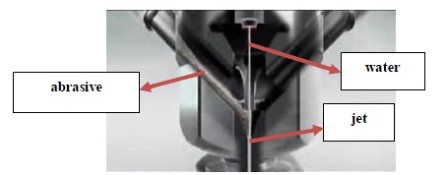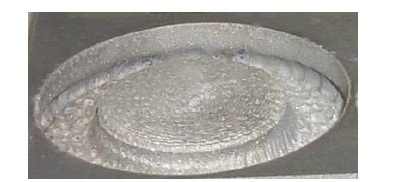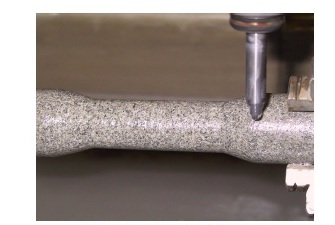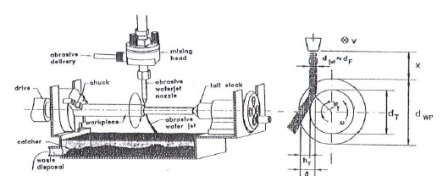Machining processes include different technologies, from which the cutting
technologies have significant importance. The waterjet cutting is a cold cutting
process, which does not cause fracture in the material. The main advantage of
waterjet cutting is that it is possible to cut a complicated planar curve with which
any other technology is not workable, so it is widely used by different industries,
such as airplane and automotive manufacturing.
The principle of waterjet cutting is the process during which a high-pressure
water column is converted into a high–speed water jet. The obtained high-speed
water jet will attack the workpieces and remove material. Two types of waterjet
cutting exist today, including plain waterjet and abrasive waterjet cutting. The difference
between them is the added abrasive powder in case of the abrasive waterjet cutting. This additive increases the effect of waterjet erosion. Due to this effect, the
range of the machinable materials increases. The great advantage of the waterjet
cutting in contrast with other technologies is that this is a cold cutting process. This
technology does not cause fracture in the material, and suited to cutting different
materials, therefore the application field is wide. The essence of the abrasive waterjet
cutting is the erosion process [1]. After passing the nozzle the water has very
high speed in the mixing chamber, abrasive powder is mixed to the water and the
abrasive water is homogenised in the mixing tube. (Figure 1) Outcoming from the
abrasive tube the jet attacks the workpieces and makes the material remove and in
the meantime different phenomena take place, like for example plastic deformation
or rigid fracture. This phenomenon can be explained with the different types of
erosion, rigid and ductile erosion.
Depending on the cutting mechanisms two types of erosion are differed: ductile
and rigid erosion. In cutting of ductile erosion material removal is caused by
plastic deformation, or ideally by a micro machining mechanism removing small
chips while in brittle erosion material removal is accomplished with the help of
crack growth and intersection of cracks. Either ductile or rigid the material is, the
material removal is accomplished by the result of number of discrete impacts, when
small particles erode the surface of the machined material [2].
abrasive water jet

Figure 1 – Abrasive waterjet cutting head
Advantages:
Х the cutting does not result in substances harmful to the environment, since
it does not use any lubricant and coolant and there is not gas-output
Х slag does not occur on the cutting surface
Х there is a wide range of the workable materials
Х the thickness of the machinable materials can be up to 30 cm
Х the loss of material can be minimized due to the small cutting gap (0.03 –
1.6 mm)
104
Х complex formations can be created
Х the temperature does not increase on the cutting surface, so the internal
properties of the cut material do not change
Disadvantages:
Х accuracy problems
Х the short lifetime of the nozzle
Х the formation of aqueous vapour
Х the splashing water and other materials during the cutting
Х the high noise level
The abrasive waterjet cutting is an environment-friendly technology, due to the
small loss of material and the non-existing chemical pollution. Moreover, there is
no need for any lubricant and other pollutant. Almost all of the materials can be
machined by waterjet cutting.
The most important materials, which can be cut by this technology are:
. non-metallic materials: the simple and the reinforced plastics, rubber,
leather, paper;
. textile;
. rigid materials: armour-glass, ceramics, rocks, concrete, construction and
cladding materials;
. tough materials: coloured metals, ferrous and non ferrous metals at any
state of heat treatment;
. soft, combustible materials, plastic foams.
Technological parameters of waterjet cutting
The quality and the accuracy of the abrasive waterjet cutting are determined
by numerous factors. The most important are the following:
. the water pressure and flow rate
. traverse feedrate
. the diameter and the geometric accuracy of the water nozzle
. the length and diameter of the abrasive nozzle
. the distance of nozzle to the workpiece
. the type of abrasive powder, the size of particle
. the abrasive mass flow
. the hardness of workable material
. cracks properties
. the thickness of plate
From among these parameters the feedrate, the pressure and the abrasive flow are
the easiest and the most common altered configuration parameters to be altered.
2. APPLICATIONS OF ABRASIVE WATERJET MACHINING
Waterjet technology has been advancing rapidly for the past three decades. In
mechanical engineering the abrasive waterjet cutting has the most important role
from among the waterjet technologies. The versatility of the abrasive water jet in
cutting almost any engineering material is a very special feature of this technology.
2.1 Milling with Abrasive Waterjet
Several concepts of milling with abrasive waterjet are developed, such as rotary
multiple waterjet head, process parameter variation principle, multi traverse
milling, mask milling, discrete milling.
The main difficulty when milling with abrasive waterjets is controlling the
depth of the cavity. In conventional milling the depth of cut is geometrically determined
by the tool shape and the feed. In case of abrasive waterjet milling there is
no direct contact or feedback from the workpiece, the depth of cut being determined
by the mechanics of the jet material interactions. An attempt to develop a
concept of abrasive waterjet milling that bases on continuously-varying dynamic
variables is not successful either. Several authors use the multipass linear-traverse
cutting as a milling strategy. This principle is based on the superposition of several
kerfs to obtain a cavity of the defined geometry [3].
In order to obtain a precise jet penetration depth, the knowledge about which
parameters that control the process is important. A problem inherent in the AWJ
process is the sensitivity to disturbances, which tends to impede any attempt to control
depth of cut. The disturbances mainly occur as uncontrolled process parameter
deviations influencing the efficiency of material removal. Typical process parameters
having major influence on the efficiency and quality of an AWJ milling operation
include traverse rate, water pressure, abrasive mass flow, abrasive grain size,
standoff distance, attack angle, nozzle diameter ratio, mixing tube length.

Figure 2 – Milling with Abrasive Waterjet
The traverse rate is an important parameter in controlling depth of cut as it directly
controls the jet-material energy transfer. Abrasive mass flow is a very impor-
tant parameter, not only for determining the efficiency of the milling process regarding
material removal rates, but also as a disturbance parameter if there are
variations over time during the milling operation. The water pressure is a relatively
important factor in influencing depth of cut and surface waviness. This parameter
determines the jet power and also increases the energy transfer to the surface [4].
2.2 Turning with Abrasive Waterjet
Turning with waterjets (Figure 3) is similar to turning with a conventional
single point tool in a lathe. The workpiece is rotated while the tool is traversed parallel
to the axis of rotation and incrementally fed towards the centre of rotation. Jet
forces on the workpiece are negligible. To improve the finish of the turned surface
the jet traversed back and forth along the component, but without lateral feed.
Figure 4 depicts the pertinent parameters in abrasive waterjet turning. From
the geometry of the process, the volume-sweep rate is


Figure 3 – Turning with Waterjet
The volume–sweep rate is the material volume swept by the combined specimen
rotation and abrasive waterjet traverse in unit time. In contrast, the true volume-
removal rate is:

Generally, the volume-removal rate is less than the volume-sweep rate,
though in a few exceptional cases (during finish turning) they are equal. The depth
of cut, hT is a function of several process parameters, very similar to simple cutting
processes. A third major target parameter in abrasive waterjet turning is the surface
quality [6].

Figure 4 – Principle and geometry of the abrasive waterjet turning [5]
3. THE POSSIBLE TRENDS OF FURTHER PROGRESS IN RESEARCH
WORK
The application of water jet for cutting needs further investigation in the machining
procedures. As the trends for that the following tasks can be assigned: investigation
of the conditions when abrasive waterjet can be applied as a cutting
edge; analysis of the kinetic relations of the machining procedures; analysis of the
geometrical relations of material removal and its efficiency.
Acknowledgement
The described work was carried out as part of the TAMOP – 4.2.1.B –
10/2/KONV – 2010 – 0001 project in the framework of the New Hungarian Development
Plan. The realization of this project is supported by the European Union, cofinanced
by the European Social Fund.
References:
1. R.A.Tikhomirov: High-pressure jet cutting, New York, 1992. pp.35 – 37.
2. Hashish, M.: The waterjet as a tool, 14th International conference on Jetting Technology, Brugge, Belgium,
21 – 23 September 1998, pp.iXX – iXLIV
3. Maros, Zs.: Abrasive Water Jet - an Efficient Cutting Tool
for Difficult – to – Machine Materials, 10th International Conference on Tools ICT – 200, 6 – 8 September
2000., Miskolc, Hungary, pp.353 – 358.
4. Ojmertz, C.: Alternative AWJ Machining Operations,
Abrasive Water Jet, a view on the future, Associazione Italiana Waterjet, Edited M. Monno, M. Strano
2000, pp.II.3.
5. Ansari A I 1990 A study on turning with abrasive waterjets, PhD thesis, Michigan
Technol. Univ., Houghton.
6. Momber, A W., Kovacevic, R.: Principles of Abrasive Water Jet Machining,
1998. pp.287 – 306.
ѕоступила в редколлегию 07.04.2011





